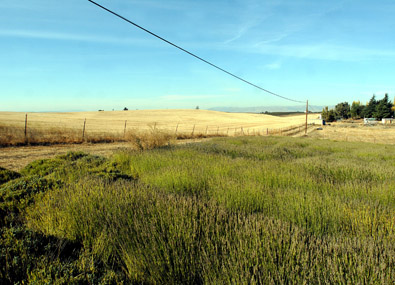
Early comments point to a multitude of concerns over college
In written comments, residents, city and county officials
expressed concern about the Environmental Impact Report for the
80-acre San Benito County campus of Gavilan College, including
concerns that range from fire protection impacts to wildlife. The
report analyzes the impact of full-size college campus and a
220-unit residential housing project proposed by Dividend Homes,
the owner of the parcel, whose plans were unclear to county
officials.
Early comments point to a multitude of concerns over college
In written comments, residents, city and county officials expressed concern about the Environmental Impact Report for the 80-acre San Benito County campus of Gavilan College, including concerns that range from fire protection impacts to wildlife. The report analyzes the impact of full-size college campus and a 220-unit residential housing project proposed by Dividend Homes, the owner of the parcel, whose plans were unclear to county officials.
Currently dry farmed, the 137-acre parcel is located at the edge of Hollister at the intersection of Airline Highway and Fairview Road.
Bordered by residential development and an organic farm, the 80-acre campus would include classrooms, dorms, a library and sports fields. Buildout will take 20 to 30 years, depending on the availability of state funding, said Steve Kinsella, president of Gavilan College.
Prepared by consultants from David. J. Powers and Associates, Inc., a San Jose-based company, Gavilan officials released the draft environmental impact report (EIR) in September.
Although the EIR concludes that the project would have a less than significant impact on county fire protection, CALFIRE staff disagree.
“We don’t have enough fire protection now. Why would we in the future if we increase population?” asked Phillip Matteson, assistant fire chief for CALFIRE.
One comment reads, “The possible addition of approximately 7,500 persons (transient or not) will create a significant impact on existing strained fire protection services.”
County officials and some local residents questioned conclusions in the EIR regarding species listed as threatened or endangered. The Mendizabals, a family that runs Fox Hollow Herbs, an organic farm that abuts the college property, say they have seen wildlife on the property.
According to the EIR the property no longer provides suitable breeding ground for the California tiger salamander, a species of special concern in California and one listed as threatened by the federal government.
“Well it’s full of water every winter,” Rey Mendizabal said. “That’s been a pond that’s been there for the last 14 years that we’ve been there.”
Another resident has also seen the amphibians.
“I’ve seen tiger salamanders on my own property, and it’s about 2,000 feet from the pond, I guess,” said Mark Dickson, a county resident who lives near the proposed college site.
The San Joaquin kit fox is listed as endangered by federal government officials and threatened in California, and is another animal locals have seen.
“I can show you where the old kit foxes dens have been,” Rey said. “I can show you that stuff.”
The site was disked repeatedly, Mendizabal said.
“There was a tractor going over day and night,” Jackie said. “It did raise a red flag. We thought, ‘Why are they doing that?’ They’re not planting there. I thought maybe they were destroying what’s left of anything.”
According to comments, the site does not provide adequate mitigations for earthquakes or traffic.
The EIR needs to clarify traffic impacts, said Pat Loe, a supervisor for San Benito County.
“I believe that there’s a lot of questions on that EIR that really need to be studied thoroughly and answered, just for the benefit of the whole community and the Gavilan board itself,” Loe said.
The EIR does not evaluate the impacts on traffic at various intersections of which Hollister officials requested analysis, including Union Road and Valley View Road, Hwy. 156 and San Juan Hollister Road, San Felipe Road and McCloskey Road and other intersections, according to written comments from Hollister officials.
The EIR relies on traffic impact fees to mitigate for traffic impacts, but those fees were not designed for a college campus project, Loe said.
“The college was not looked at in that traffic study, so that’s just a false opinion that they have,” she said.
Art Henriques, the director of planning and building for San Benito County, said he wants more clarification on the housing development.
“Once they can give us some clarification, it would help quite a bit, because we’d like to know what exactly the board of trustees is going to be asked to approve before they approve it in a few months. Right now some of these points are too open ended, so the county doesn’t know do we have jurisdiction or not.”
The EIR doesn’t make clear if the housing will be entirely private, or will mix faculty and student housing.
The site is still viable but not a done deal, Kinsella said.
“Based on the information that we have right now, the site is still a viable site,” Kinsella said. “If something comes up during the EIR that looks like this is not going to be, then we would throw it out and start all over again. The board won’t be asked to make a decision until the EIR has been proposed for certification.”
Schools are unusual because their governing body is the school board. Unlike other public and private entities, the body that submits the EIR is the same one that must certify the EIR – the school board.
Kinsella said he hopes board members will give final approval to buy the property by the end of the year.
The timeline depends on EIR comments. Some comments could require more detailed analysis in the final EIR.
“According to the Calfornia Environmental Quality Act (CEQA), comments received on the Draft EIR during the public comment period are responded to in the form of official responses in the Final EIR,” wrote Julie Mier, a project manager for David J. Powers, in an e-mail. She declined to speak about the comments.
Gavilan officials initially investigated 16 sites, according to the EIR. The criteria included cost, accessibility, and other factors. The board initially allocated $12.7 million of Measure E funds, a bond passed in 2004, for the San Benito campus. Kinsella estimated $8 million will be spent on land acquistion and $4 million for preparation of the site, which includes activities such as installing utilities to ready the site for construction.
“This location meets more of the criteria than any of the other sites that were studied,” Kinsella said, in an e-mail.
Kinsella said the requirement of 80 acres of land for the campus eliminated sites near downtown Hollister.
“We know there is no site that will meet our 80-acre requirement,” Kinsella wrote. “In our view there is no option available to the college to choose a downtown location. Selecting a downtown location would require that the college compromise on its intent to establish a full college campus in San Benito County.”
Kinsella said he does not know if the college officials will seek another bond to fund classroom construction.
“I can’t even speculate on that,” Kinsella said. “It’s never even been discussed. We wanted to do as much as we could to plan for future growth, and that’s what we’ve done with this bond measure.”
Still, residents who live near the proposed site have misgivings, including Jackie and Rey Mendizabal. They worry the location of the site may put their status as an organic farm in jeopardy.
“Our bulk that would be affected would be lavender,” Jackie said. “We have about two acres of lavender.”
The field cannot be relocated because lavender is a perennial, Jackie said.
“We’re worried that anything they would use on their lawns, and anything they would spray for weeds, it would go directly on our fields,” she said.
If United States Department of Agriculture staff test her fields and find pesticides, it could put her organic status in danger.
“It’s important,” she said. “Your pricing of things is increased when you do organic. A lot of my customers, they won’t even go to your booth of it’s not organic.”
If the campus is not complete for 20 or 30 years, Jackie said that is fine with her.
“We just plan on building a big old row of trees when we know the campus is going in,” she said. “Just, plant, plant, plant. We’ve been lucky to be here all these years without anything bothering us next door. I know change is always coming around.”









